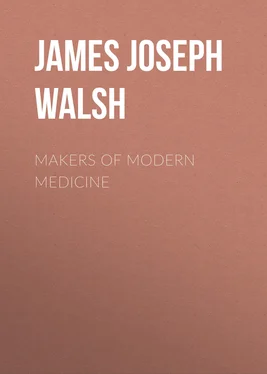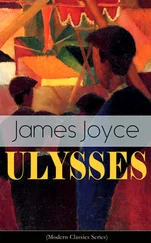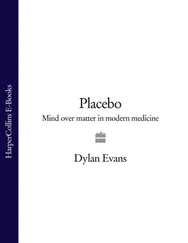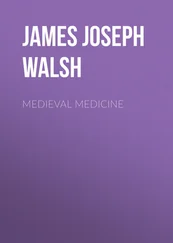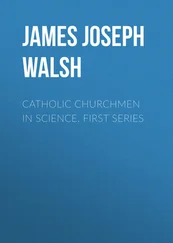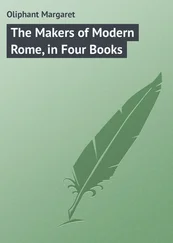James Walsh - Makers of Modern Medicine
Здесь есть возможность читать онлайн «James Walsh - Makers of Modern Medicine» — ознакомительный отрывок электронной книги совершенно бесплатно, а после прочтения отрывка купить полную версию. В некоторых случаях можно слушать аудио, скачать через торрент в формате fb2 и присутствует краткое содержание. Жанр: foreign_prose, Медицина, foreign_antique, на английском языке. Описание произведения, (предисловие) а так же отзывы посетителей доступны на портале библиотеки ЛибКат.
- Название:Makers of Modern Medicine
- Автор:
- Жанр:
- Год:неизвестен
- ISBN:нет данных
- Рейтинг книги:3 / 5. Голосов: 1
-
Избранное:Добавить в избранное
- Отзывы:
-
Ваша оценка:
- 60
- 1
- 2
- 3
- 4
- 5
Makers of Modern Medicine: краткое содержание, описание и аннотация
Предлагаем к чтению аннотацию, описание, краткое содержание или предисловие (зависит от того, что написал сам автор книги «Makers of Modern Medicine»). Если вы не нашли необходимую информацию о книге — напишите в комментариях, мы постараемся отыскать её.
Makers of Modern Medicine — читать онлайн ознакомительный отрывок
Ниже представлен текст книги, разбитый по страницам. Система сохранения места последней прочитанной страницы, позволяет с удобством читать онлайн бесплатно книгу «Makers of Modern Medicine», без необходимости каждый раз заново искать на чём Вы остановились. Поставьте закладку, и сможете в любой момент перейти на страницу, на которой закончили чтение.
Интервал:
Закладка:
There is an old proverb that runs Ubi tres medici ibi duo athei , –where there are three physicians there are at least two atheists. This has made many a heartache for fond mothers when they found their sons had determined on becoming physicians. If the present series of sketches is to be taken as any argument, however, it is only the small minds among physicians who become atheists. They are not able to see their way clearly from the material they work in to the higher things that prove a source of strength and consolation to the great minds while they are busy making medicine for their own and subsequent generations. Certainly no more thoroughly representative group of the makers of nineteenth century clinical medicine could have been selected than those whose sketches are here given. They are from all the nations who have contributed materially to modern medical advance, yet all of them were deeply religious men. There is another and equally important point with regard to them. It is their relations to their fellows. Without exception they were men beloved by those around them for their unselfish devotion not only to science, but also to their brother men. In the midst of their occupations the thought that has been the profoundest consolation for all of them without exception has been that they were accomplishing something by which their fellow-men would be saved suffering and by which human life would be made more happy. A study of their careers cannot fail to show the young physician the ideals he must cherish if he would have real and not apparent success and happiness in life.
MORGAGNI, THE FATHER OF PATHOLOGY
Let us then blush, in this so ample and so wonderful field of nature (where performance still exceeds what is promised), to credit other men's traditions only, and thence come uncertain problems to spin out thorny and captious questions. Nature herselfe must be our adviser; the path she chalks must be our walk; for so while we confer with our own eies, and take our rise from meaner things to higher, we shall at length be received into her closet-secrets.
--Preface to Anatomical Exercitations concerning the Generation of Living Creatures , 1653. William Harvey."VIR INGENII, MEMORIAE, STUDII, INCOMPARABILIS."
–-HALLER.
In 1894, when the International Medical Congress met at Rome, Prof. Virchow of Berlin, the greatest living pathologist at the time, was asked to deliver the principal address. He chose as his subject John Baptist Morgagni, the distinguished Italian physician and original investigator of the eighteenth century, whom he hailed as the Father of Pathology. No medical scientist of the nineteenth century was in a better position than Virchow to judge who had been the founder of the science for which he himself did so much. Virchow besides, through long and faithful study of the history of medicine, knew well whereof he spoke. In pathology especially modern medicine has made its sure advances, so that Morgagni's ground-breaking work may well be considered the beginning of the most recent epoch in medical science. As a matter of fact, medicine lost much of its obscurity by losing all its vagueness when Morgagni's methods came into general use.
As a medical student scarcely twenty years of age, he revolutionized medical observation by studying his fatal cases with a comparative investigation of their clinical symptoms and the postmortem findings. This had been done before, but mainly with the idea of finding out the cause of death and the principal reasons for the illness which preceded. Morgagni's investigations in pathology consisted in tracing side by side all the clinical symptoms to their causes as far as that might be possible. This looks so simple now as to be quite obvious, as all great discoveries are both simple and obvious once they have been made; but it takes a genius to make them, since their very nearness causes them to be overlooked by the ordinary observer so prone to seek something strange and different from the common.
How much Morgagni's studies from this new viewpoint of the investigation of all the symptoms of disease has meant for modern medicine, may be best appreciated by a quotation from an address delivered before the Glasgow Pathological and Clinical Society in 1864, by Professor Gairdner, who thus tersely describes the character of the distinguished Italian pathologist's work:
"In investigating the seats of disease, Morgagni is not content to record the coincidence of a lesion in an organ with the symptoms apparently due to disordered function in that organ.
"For the first time almost in medical inquiry, he insists on examining every organ, as well as the one suspected to be chiefly implicated; not only so, he marshals with the utmost care, from his own experience and that of his predecessors, all the instances in which the symptoms have existed apart from the lesion, or the lesion apart from the symptoms. He discusses each of these incidents with severe exactness in the interest of truth, and only after an exhaustive investigation will he allow the inference either that the organ referred to is or is not the seat of the disease.
"And in like manner in dealing with causes: a group of symptoms may be caused by certain organic changes–it may be even probable that it is so–but, according to Morgagni's method, we must first inquire into all the lesions of organs which occur in connection with such symptoms; in the second place, we must know if such lesions ever occur without the symptoms; and again if such symptoms can be attributed in any cases to other causes in the absence of such lesions."
During over sixty years of a long life Morgagni continued to follow out the idea that he had developed as a boy, and his works contain the first definite account of pathological lesions and clinical manifestations that attracted attention.
As a proof of the striking difference between the value of observation and theory in medicine, it may be said that many hundreds of volumes containing the most elaborate medical theories were published during the eighteenth century, and that practically none of these is ever read now, except for curiosity's sake by some seeker after the quaint and distant in medicine, while Morgagni's books still contain a precious fund of information, to which pathologists at least, and not a few clinicians, turn often with interest and come away always with profit. They are not infrequently quoted from, and, as we shall see, have been highly appreciated by some of the best medical authorities of the present and the immediately preceding generations.
To the modern thinker, accustomed to look rather to the northern nations or to France for great advances in science, it may prove somewhat of a surprise to have an Italian thus put forward as the founder of modern medicine, and especially of the most scientific department of it. Those who are familiar with the history of medicine since the revival of civilization after the Dark Ages will realize what a prominent place Italy has always held in the development of medical science. The first great Christian medical school was founded at Salerno, not far from Naples, in the tenth century. The first regular practical teaching of anatomy by means of dissections of human bodies and demonstrations on the cadaver was done at Bologna by Mondino at the beginning of the fourteenth century. The great Father of Modern Anatomy, Vesalius, was a Belgian, but he did all the work for his epoch-making book, the De Fabrica Humani Corporis , at the Universities of North Italy, especially at Padua, Bologna and Pisa, during the first half of the sixteenth century. Every student of medicine in those times who was desirous to secure wider opportunities for medical education went down into Italy, and on the rosters of the Italian medical schools of the sixteenth century are to be found the names of most of the men who in all the countries of Europe became famous for their medical attainments.
Читать дальшеИнтервал:
Закладка:
Похожие книги на «Makers of Modern Medicine»
Представляем Вашему вниманию похожие книги на «Makers of Modern Medicine» списком для выбора. Мы отобрали схожую по названию и смыслу литературу в надежде предоставить читателям больше вариантов отыскать новые, интересные, ещё непрочитанные произведения.
Обсуждение, отзывы о книге «Makers of Modern Medicine» и просто собственные мнения читателей. Оставьте ваши комментарии, напишите, что Вы думаете о произведении, его смысле или главных героях. Укажите что конкретно понравилось, а что нет, и почему Вы так считаете.
